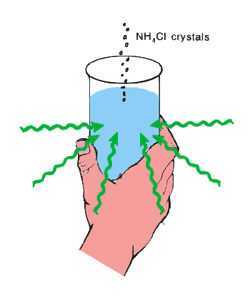|
Another example is the cooling effect when a salt such as ammonium chloride is dissolved in water (right). The reaction:
An even simpler example is the vaporization of water. The heat of vaporization at room temperature is DH0= +10.5 kcal mole-1. Heats of vaporization for all liquids are positive because energy is required to break the attractive forces between molecules in the liquid and create a gas. Yet evaporation frequently is spontaneous. If only heat-yielding processes were spontaneous, then all gases in the universe would condense to liquids, all liquids would freeze to crystalline solids, and the world would be nothing but rock and ice. This obviously is not so, and energy obviously cannot be the only factor in making chemical reactions spontaneous. |
 Ammonium Chloride crytals dropped into water absorb heat from the surroundings as they dissolve. The tumbler feels cold to the touch. |
